Alcohol Consumption and Beverage Preferences in a Predominantly Female, Highly Educated Spanish Population: A Sociodemographic and Network Analysis
Abstract
1. Introduction
2. Materials and Methods
2.1. Type of Study and Sampling
2.2. Ethical Requirements
2.3. Data Collection
2.4. Measurements
2.4.1. Sociodemographic Variables
2.4.2. IASE Healthy Eating Index for the Spanish Population
2.4.3. Potential Eating Disorders Variables
2.4.4. Nutritional, Beverage Consumption, Health and Lifestyle Variables
2.4.5. Type of Alcohol Consumed
- -
- Fermented beverages (Wine, Champagne, Cava, Beer, Cider, Vermouth, Sake, etc.);
- -
- Distilled beverages (Whisky, Vodka, Tequila, Rum, Gin, Pisco, Orujo, Brandy, Cognac, etc.);
- -
- Fortified beverages (Fortified wine, Port, Sherry, Madeira, Manzanilla, Palomino, etc.);
- -
- Liqueurs and creams (Liqueurs, Pacharán, Amaretto, Cream of orujo, etc.).
2.5. Data Analysis
3. Results
3.1. Sociodemographic Characteristics
3.2. Analysis of the Alcohol Consumption
3.3. Analysis of the Type of Alcohol Consumed
3.4. Gaussian Graphical Model Between Different Types of Alcohol and Other Beverages
4. Discussion
4.1. Network Analysis Results
4.2. Strengths and Limitations
4.3. Areas for Further Research
5. Conclusions
Author Contributions
Funding
Institutional Review Board Statement
Informed Consent Statement
Data Availability Statement
Acknowledgments
Conflicts of Interest
Abbreviations
| Alc | Alcohol |
| Frmb | Fermented beverages |
| Dsb | Distilled beverages |
| Frtb | Fortified beverages |
| Lac | Liqueurs and creams |
| Gtd | Getting drunk |
| Cff | Coffee |
| Wtr | Water |
| Juc | Juice |
| Sfd | Soft drinks |
Appendix A
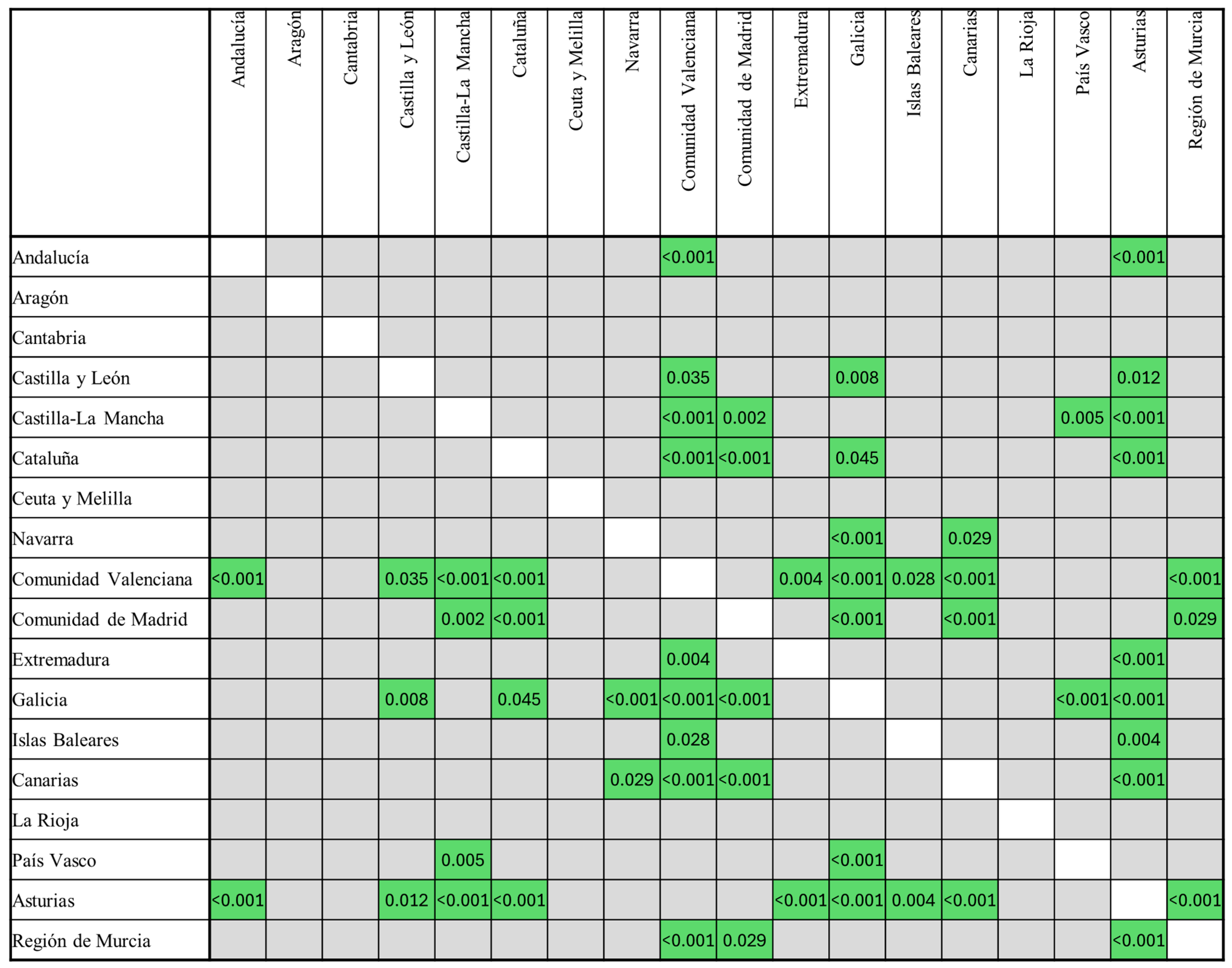
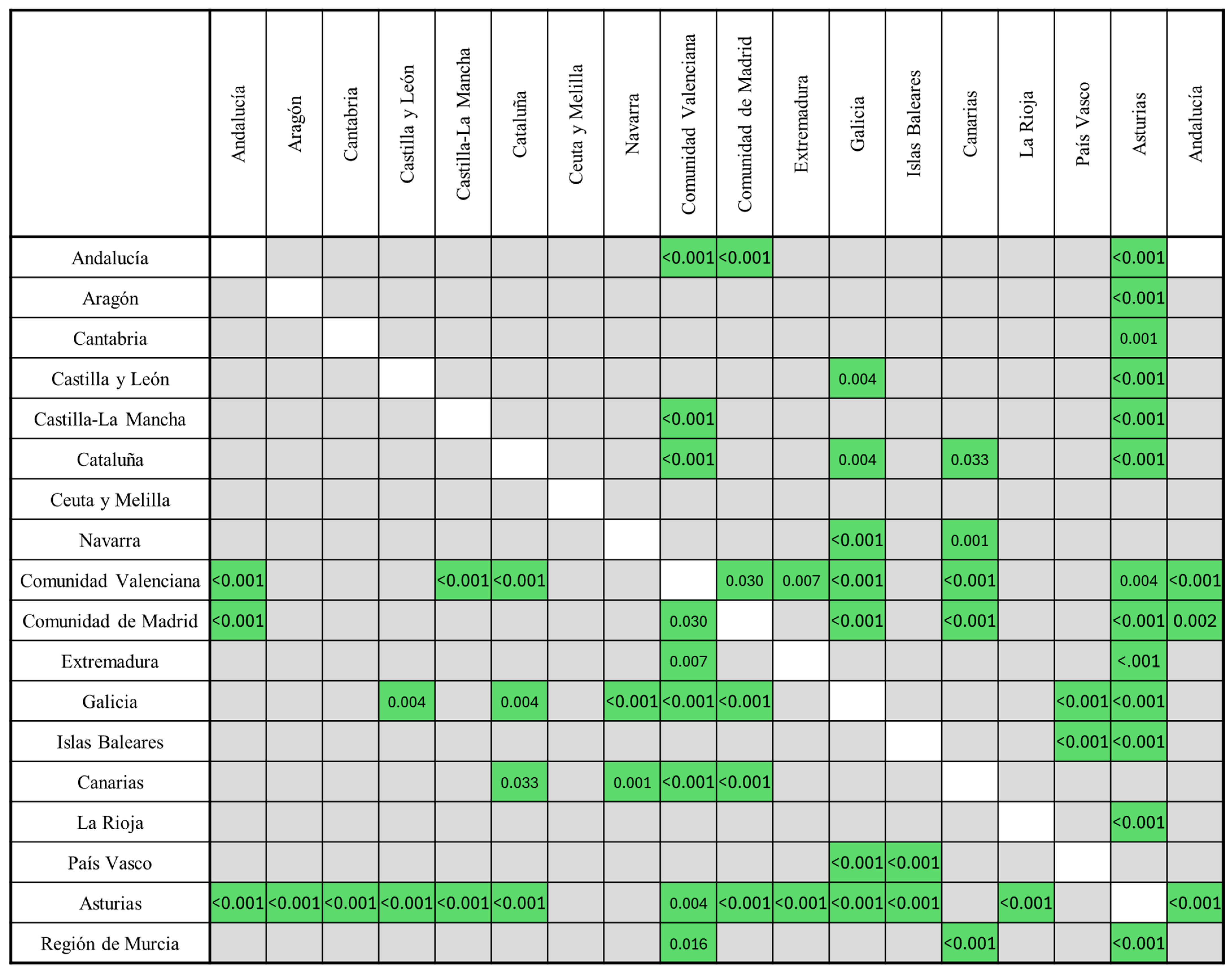
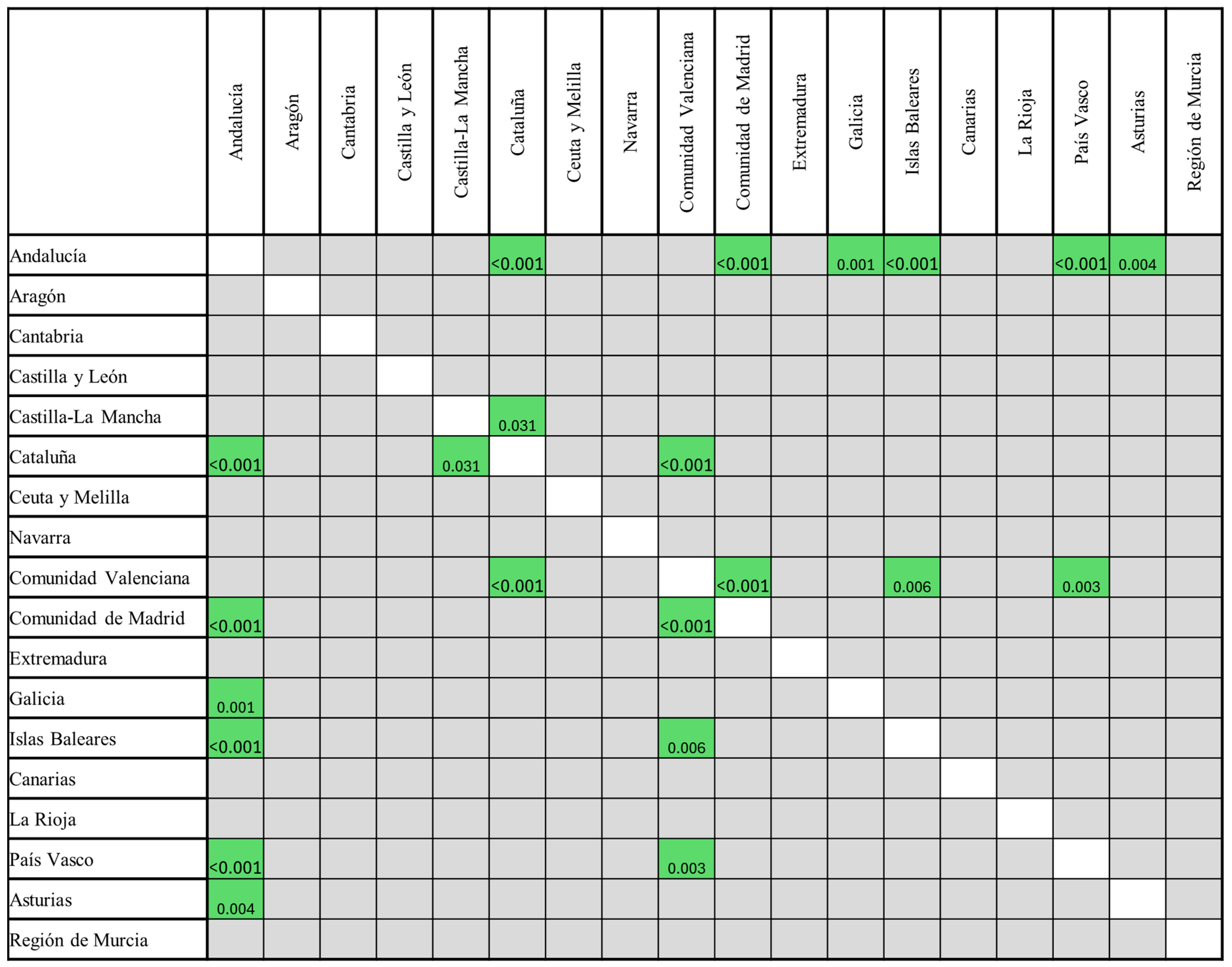

Appendix B
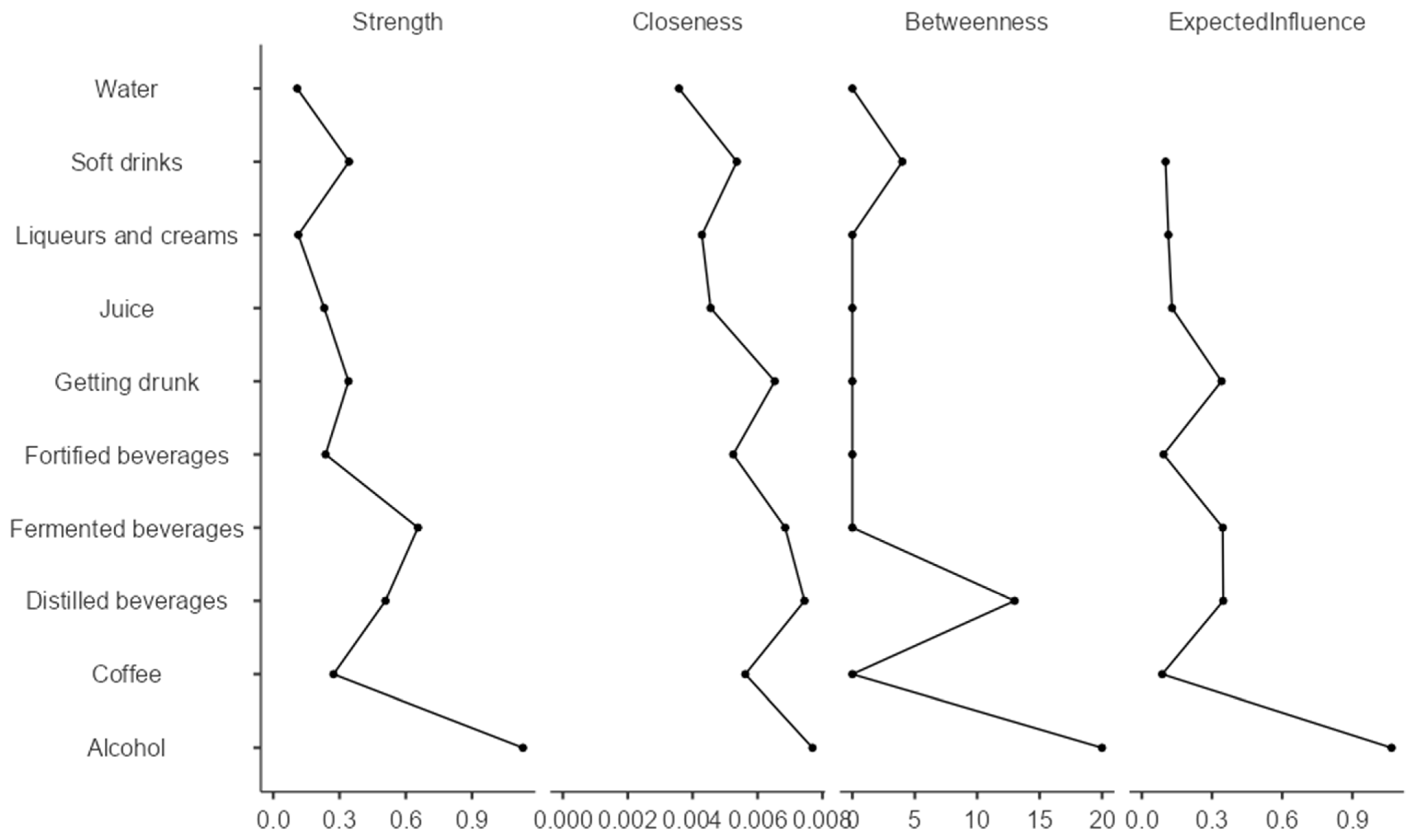
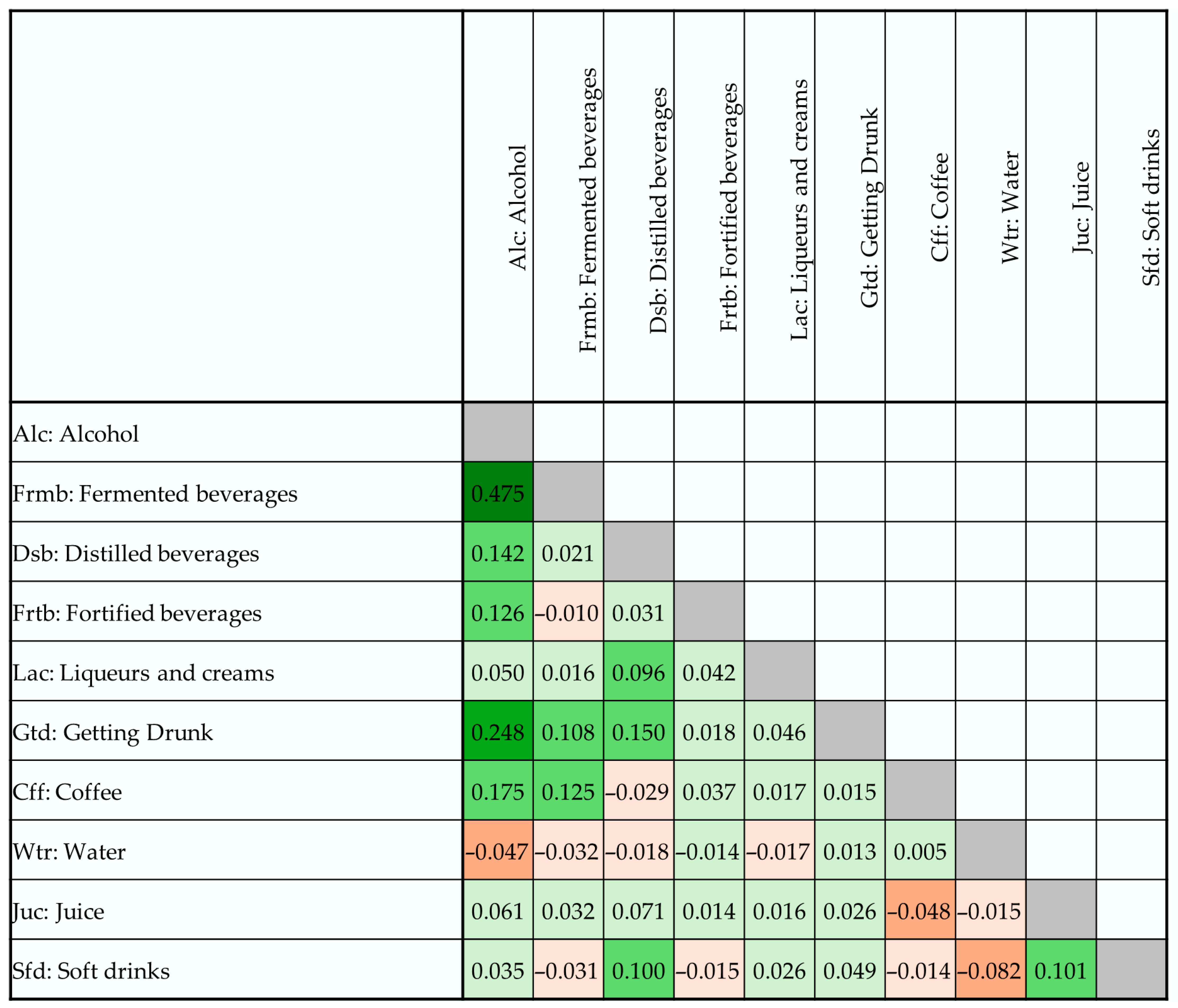
References
- World Health Organization. Global Status Report on Alcohol and Health; WHO: Geneva, Switzerland, 2018. [Google Scholar]
- Lo Monaco, G.; Bonetto, E.; Codaccioni, C.; Araujo, M.V.; Piermattéo, A. Alcohol ‘Use’ and ‘Abuse’: When Culture, Social Context, and Identity Matter. Curr. Opin. Food Sci. 2020, 33, 9–13. [Google Scholar] [CrossRef]
- Córdoba García, R.; Robledo, T.; Nebot, M.; Cabezas, C.; Megido, M.J.; Marques, F.; Muñoz, E.; Camarelles, F. Alcohol, Wine, and Health: Myths and Realities. Prim. Care 2007, 39, 637–639. [Google Scholar] [CrossRef]
- Parque, S.H.; Kim, D.J. Global and Regional Impacts of Alcohol Consumption on Public Health: Emphasis on Alcohol Policies. Clin. Mol. Hepatol. 2020, 26, 652–661. [Google Scholar] [CrossRef]
- Ministerio de Sanidad, Secretaría de Estado de Sanidad, Delegación del Gobierno para el Plan Nacional sobre Drogas. Spanish Alcohol Report 2021: Consumption and Consequences. Summary Report; Ministerio de Sanidad: Madrid, Spain, 2021. Available online: https://pnsd.sanidad.gob.es/profesionales/publicaciones/catalogo/catalogoPNSD/publicaciones/pdf/2021_Summary_Report_ALCOHOL_2021_SPAIN.pdf (accessed on 17 November 2024).
- Calafat, A. Estrategias Preventivas del Abuso de Alcohol. Adicciones 2002, 14 (Suppl. S1), 317–335. [Google Scholar] [CrossRef]
- Fontán-Vela, J.; Ortiz, C.; López-Cuadrado, T.; Téllez-Plaza, M.; García-Esquinas, E.; Galán, I. Patrones de Consumo de Alcohol y Adherencia a la Dieta Mediterránea en la Población Adulta de España. Eur. J. Nutr. 2024, 63, 881–891. [Google Scholar] [CrossRef]
- Gilbert, D.C. Touristic Development of a Viticultural Region of Spain. Int. J. Wine Mark. 1992, 4, 25–32. [Google Scholar] [CrossRef]
- Antoñanzas Villar, F.; Martínez-Zárate, M.P.; Pradas Velasco, R. Las Bebidas Alcohólicas en España: Salud y Economía. Gac. Sanit. 2008, 22, 175–178. [Google Scholar] [CrossRef] [PubMed]
- Vilanova, M.; Vilariño, F. Influence of Geographic Origin on Aromatic Descriptors of Spanish Albariño Wine. Flavour Fragr. J. 2006, 21, 373–378. [Google Scholar] [CrossRef]
- Cobo, G.; Ruiz-Moreno, C. Wine and Health: Consumption Trends in Spain. Nutrients 2020, 12, 1377. [Google Scholar]
- Riu-Aumatell, M.; Bosch-Fusté, J.; López-Tamames, E.; Buxaderas, S. Development of Volatile Compounds of Cava (Spanish Sparkling Wine) during Long Ageing Time in Contact with Lees. Food Chem. 2006, 95, 237–242. [Google Scholar] [CrossRef]
- Luchian, C.E.; Grosaru, D.; Scutarașu, E.C.; Colibaba, L.C.; Scutarașu, A.; Cotea, V.V. Advancing Sparkling Wine in the 21st Century: From Traditional Methods to Modern Innovations and Market Trends. Fermentation 2025, 11, 174. [Google Scholar] [CrossRef]
- Bamforth, C.W.; Ward, R.E. (Eds.) Other Fermented Beverages. In The Oxford Handbook of Food Fermentations; Oxford Handbooks: Oxford, UK, 2014; Available online: https://global.oup.com/academic/product/the-oxford-handbook-of-food-fermentations-9780199742707?cc=jp&lang=en& (accessed on 14 April 2025).
- Casadó-Marín, L.; Anzil, V. The Semiotics of Wine: Analysis of Wine-Related Cultural Consensus in Two Spanish Wine-Producing Regions. Int. J. Gastron. Food Sci. 2022, 28, 100536. [Google Scholar] [CrossRef]
- Valcárcel-Muñoz, M.J.; Guerrero-Chanivet, M.; García-Moreno, M.V.; Rodríguez-Dodero, M.C.; Guillén-Sánchez, D.A. Comparative Evaluation of Brandy de Jerez Aged in American Oak Barrels with Different Times of Use. Foods 2021, 10, 288. [Google Scholar] [CrossRef] [PubMed]
- Ángeles Pozo-Bayón, M.; Victoria Moreno-Arribas, M. Sherry Wines. Adv. Food Nutr. Res. 2011, 63, 17–40. [Google Scholar] [CrossRef] [PubMed]
- Cortés-Diéguez, S.; Otero-Cerviño, C.; Rodeiro-Mougán, H.; Feijóo-Mateo, J.A. Quantitative Descriptive Analysis of Traditional Herbal and Coffee Liqueurs Made with Grape Marc Spirit (Orujo). Foods 2020, 9, 753. [Google Scholar] [CrossRef]
- Pons-Mercadé, P.; Giménez, P.; Gombau, J.; Vilomara, G.; Conde, M.; Cantos, A.; Rozès, N.; Canals, J.M.; Zamora, F. Oxygen Consumption Rate of Lees during Sparkling Wine (Cava) Aging: Influence of the Aging Time. Food Chem. 2021, 342, 128238. [Google Scholar] [CrossRef] [PubMed]
- Moure-Rodríguez, L.; Caamano-Isorna, F. We Need to Delay the Age of Onset of Alcohol Consumption. Int. J. Environ. Res. Public Health 2020, 17, 2739. [Google Scholar] [CrossRef]
- Villanueva-Blasco, V.J.; Villanueva Silvestre, V.; Isorna, M.; Motos, P.; Blay, P.; Vázquez-Martínez, A. Changes in Alcohol Consumption Pattern Based on Gender during COVID-19 Confinement in Spain. Int. J. Environ. Res. Public Health 2021, 18, 8028. [Google Scholar] [CrossRef]
- Beard, E.; Brown, J.; West, R.; Kaner, E.; Meier, P.; Michie, S. Associations between Socio-Economic Factors and Alcohol Consumption: A Population Survey of Adults in England. PLoS ONE 2019, 14, e0213552. [Google Scholar]
- Rutagand, E. The Role of Cultural Festivals in Promoting Social Cohesion and Cultural Understanding. Int. J. Humanit. Soc. Sci. 2024, 3, 13–25. [Google Scholar] [CrossRef]
- World Medical Association. World Medical Association Declaration of Helsinki: Ethical Principles for Medical Research Involving Human Participants. JAMA 2025, 333, 71–74. [Google Scholar] [CrossRef] [PubMed]
- Sandri, E.; Piredda, M.; De Maria, M.; Mancin, S.; Sguanci, M.; Cabo, A.; Olmedo, G.C. Development and Psychometric Testing of the Nutritional and Social Health Habits Scale (NutSo-HH): A Methodological Review of Existing Tools. MethodsX 2024, 12, 102768. [Google Scholar] [CrossRef]
- Ministerio de Trabajo y Economía Social. Real Decreto 231/2020, de 4 de Febrero, Por El Que Se Fija El Salario Mínimo Interprofesional Para 2020; BOE: Madrid, Spain, 2020; pp. 10814–10818. Available online: https://www.boe.es/eli/es/rd/2020/02/04/231 (accessed on 14 April 2025).
- Norte Navarro, A.I.; Ortiz Moncada, R. Spanish Diet Quality According to the Healthy Eating Index. Nutr. Hosp. 2011, 26, 330–336. [Google Scholar] [CrossRef]
- Grupo Colaborativo de la Sociedad Española de Nutrición Comunitaria (SENC). Guías Alimentarias para la Población Española; la Nueva Pirámide de la Alimentación Saludable. Nutr. Hosp. 2016, 33, 1–48. Available online: https://www.nutricioncomunitaria.org/es/noticia/guia-de-alimentacion-saludablesenc (accessed on 22 November 2024).
- Sandri, E.; Borghesi, D.; Cantín Larumbe, E.; Cerdá Olmedo, G.; Vega-Bello, M.J.; Bernalte Martí, V. Intermittent Fasting: Socio-Economic Profile of Spanish Citizens Who Practice It and the Influence of This Dietary Pattern on the Health and Lifestyle Habits of the Population. Nutrients 2024, 16, 2028. [Google Scholar] [CrossRef] [PubMed]
- Sandri, E.; Cantín Larumbe, E.; Capoferri, M.; Cerdá Olmedo, G.; Werner, L.U.; Vega-Bello, M.J. Socio-Demographic Determinants of Dietary Choices and Their Impact on Health in Spanish Adults. Front. Public Health 2024, 12, 1417925. [Google Scholar] [CrossRef]
- Sandri, E.; Modesto i Alapont, V.; Cantín Larumbe, E.; Cerdá Olmedo, G. Analysis of the Influence of Socio-Demographic Variables and Some Nutrition and Lifestyle Habits on Beverage Consumption in the Spanish Population. Foods 2023, 12, 4310. [Google Scholar] [CrossRef]
- Jamovi. Open Statistical Software for the Desktop and Cloud. 2024. Available online: https://www.jamovi.org/ (accessed on 22 November 2024).
- Online Statistics Calculator. Hypothesis Testing, T-Test, Chi-Square, Regression, Correlation, Analysis of Variance, Cluster Analysis. 2024. Available online: https://datatab.net/ (accessed on 22 November 2024).
- Kerr-Corrêa, F.; Igami, T.Z.; Hiroce, V.; Tucci, A.M. Patterns of Alcohol Use between Genders: A Cross-Cultural Evaluation. J. Affect. Disord. 2007, 102, 265–275. [Google Scholar] [CrossRef]
- Piazza-Gardner, A.K.; Gaffud, T.J.; Barry, A.E. The Impact of Alcohol on Women’s Health: A Review of the Literature. Int. J. Environ. Res. Public Health 2022, 19, 4523. [Google Scholar] [CrossRef]
- Slade, T.; Chapman, C.; Swift, W.; Keyes, K.; Tonks, Z.; Teesson, M. Birth cohort trends in the global epidemiology of alcohol use and alcohol-related harms in men and women: Systematic review and metaregression. BMJ Open 2016, 6, e011827. [Google Scholar] [CrossRef]
- White, A.; Castle, I.J.P.; Chen, C.M.; Shirley, M.; Roach, D.; Hingson, R. Converging patterns of alcohol use and related outcomes among females and males in the United States, 2002 to 2012. Alcohol Clin. Exp. Res. 2015, 39, 1712–1726. [Google Scholar] [CrossRef] [PubMed]
- Ruiz, S.M.; Oscar-Berman, M. Closing the Gender Gap: The Case for Gender-Specific Alcoholism Research. J. Alcohol Drug Depend. 2013, 1, e106. [Google Scholar] [CrossRef] [PubMed]
- Varela-Moreiras, G.; Avila, J.M.; Cuadrado, C.; del Pozo, S.; Ruiz, E. Food consumption patterns in Spain: A comparison with European Mediterranean countries. Nutrients 2021, 13, 1647. [Google Scholar] [CrossRef]
- Díaz-Geada, A.; Busto Miramontes, A.; Veloso-Melón, J.; Caamaño-Isorna, F. Patterns of alcohol consumption in Spanish youth: Associated risk and protective factors. Adicciones 2014, 26, 282–292. [Google Scholar] [CrossRef]
- Anderson, P.; Baumberg, B.; Rossow, I. Closing the Gender Gap in Alcohol Use: Trends in Consumption and Implications for Health Policy. Addict. Res. Theory 2021, 29, 375–389. [Google Scholar]
- Garcia, A.; Ramos, F. Cultural Influences on Alcohol Consumption in Spain and the Americas. Int. J. Alcohol Stud. 2016, 14, 102–118. [Google Scholar]
- Landsverk, G. The Mediterranean Diet Includes Wine in Moderation. Can a Little Alcohol be Good for You? Business Insider: New York, NY, USA, 2025; Available online: https://www.businessinsider.com/blue-zone-wine-healthy-mediterranean-diet-2025-1 (accessed on 14 May 2025).
- Villar, A.; Rodríguez, L.; Pérez, M. Gender Differences in Survey Participation: Exploring Motivations and Barriers in Social and Health Studies. J. Soc. Res. Methods 2020, 35, 45–60. [Google Scholar]
- DiBello, A.M.; Neighbors, C.; Rodriguez, L.M.; Lindgren, K.P. Self-Esteem Mediates the Effects of Loneliness on Problematic Alcohol Use. Addict. Behav. 2023, 132, 107345. [Google Scholar] [CrossRef]
- Pérez, D.; Torres, J. Alcohol Preferences in Southern Europe: Historical and Contemporary Perspectives. J. South. Eur. Stud. 2022, 30, 304–319. [Google Scholar]
- González, R.; Ortega, L. Geographical and Cultural Variations in Alcohol Preferences: The Case of Northern Spain. Cult. Stud. Spain 2019, 19, 89–103. [Google Scholar]
- Guillou Landreat, M.; Beauvais, C.; Grall Bronnec, M.; Le Goff, D.; Le reste, J.Y.; Lever, D.; Dany, A.; Gallopel Morvan, K. Alcohol use disorders, beverage preferences and the influence of alcohol marketing: A preliminary study. Subst. Abuse Treat Prev. Policy 2020, 15, 90. [Google Scholar] [CrossRef] [PubMed]
- Kuntsche, E.; Rehm, J.; Gmel, G. Characteristics of alcohol use in the European Union. Addiction 2006, 101, 1558–1568. [Google Scholar] [CrossRef]
- Bloomfield, K.; Stockwell, T.; Gmel, G.; Rehn, N. International comparisons of alcohol consumption. Alcohol Res. Health 2003, 27, 95–109. [Google Scholar] [PubMed] [PubMed Central]
- Collins, S.E. Associations Between Socioeconomic Factors and Alcohol Outcomes. Alcohol Res. 2016, 38, 83–94. [Google Scholar] [PubMed] [PubMed Central]
- Rodriguez-Sanchez, C.; Sancho-Esper, F.; Casaló, L.V. Understanding Adolescent Binge Drinking in Spain: How School Information Campaigns Moderate the Role of Perceived Parental and Peer Consumption. Health Educ. Res. 2018, 33, 361–374. [Google Scholar] [CrossRef]
- Delgado, J.; Álvarez, C. Traditional Alcoholic Beverages in Spain: A Study of Regional Consumption Patterns. Food Drink Hist. Rev. 2021, 28, 76–89. [Google Scholar]
- Stanesby, O.; Labhart, F.; Dietze, P.; Wright, C.J.C.; Kuntsche, E. The Contexts of Heavy Drinking: A Systematic Review of the Combinations of Context-Related Factors Associated with Heavy Drinking Occasions. PLoS ONE 2019, 14, e0218465. [Google Scholar] [CrossRef]
- Sun, Y.H. Health concern, food choice motives, and attitudes toward healthy eating: The mediating role of food choice motives. Appetite 2008, 51, 42–49. [Google Scholar] [CrossRef]
- Karam, J.; Haddad, C.; Sacre, H.; Serhan, M.; Salameh, P.; Jomaa, L. Financial wellbeing and quality of life among a sample of the Lebanese population: The mediating effect of food insecurity. Front. Nutr. 2022, 9, 906646. [Google Scholar] [CrossRef]
- Urhan, M.; Okut Aysin, E. Nutritional and health behaviour predictors of the weight gain during the COVID-19 pandemic. Eur. J. Nutr. 2022, 61, 2993–3002. [Google Scholar] [CrossRef]
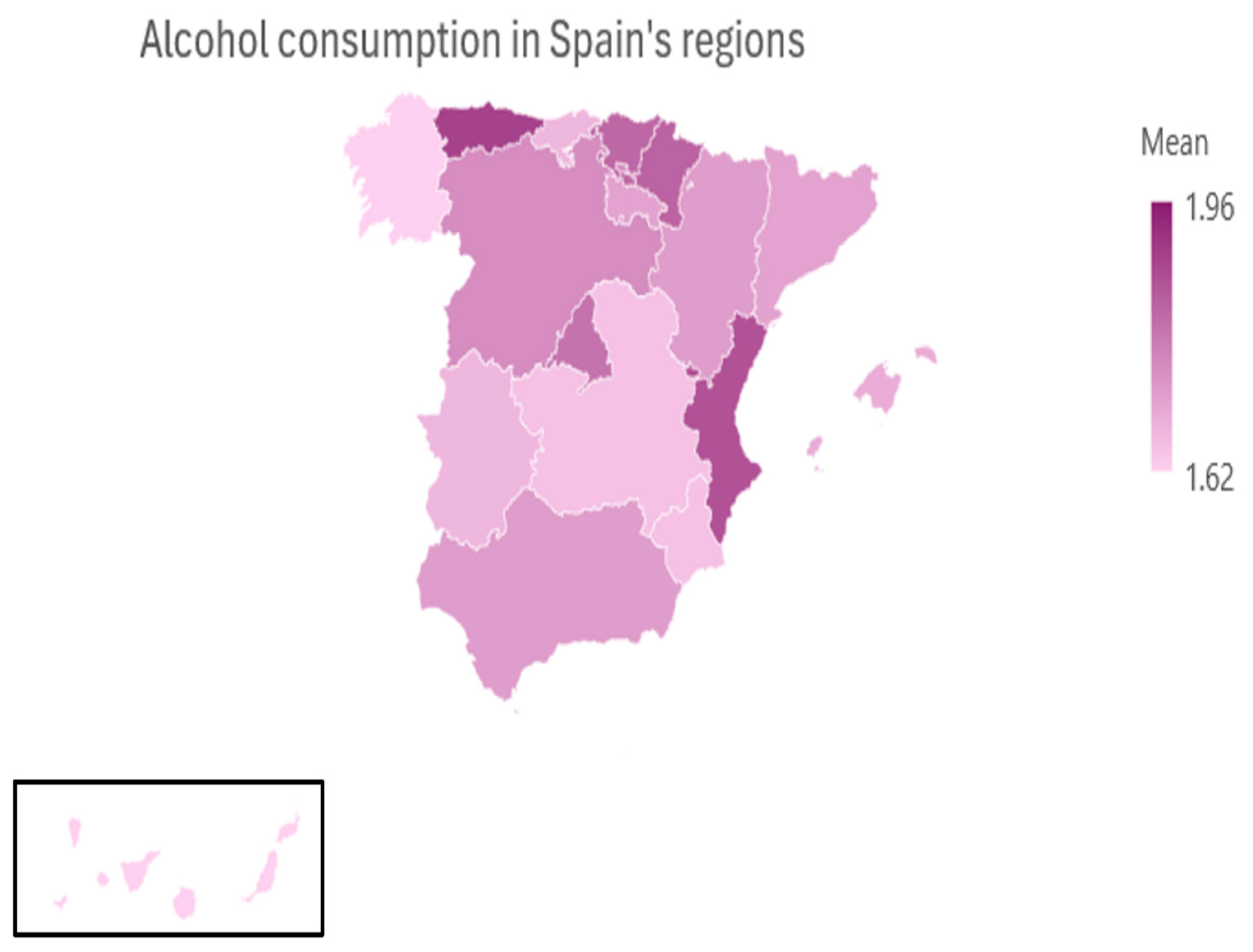
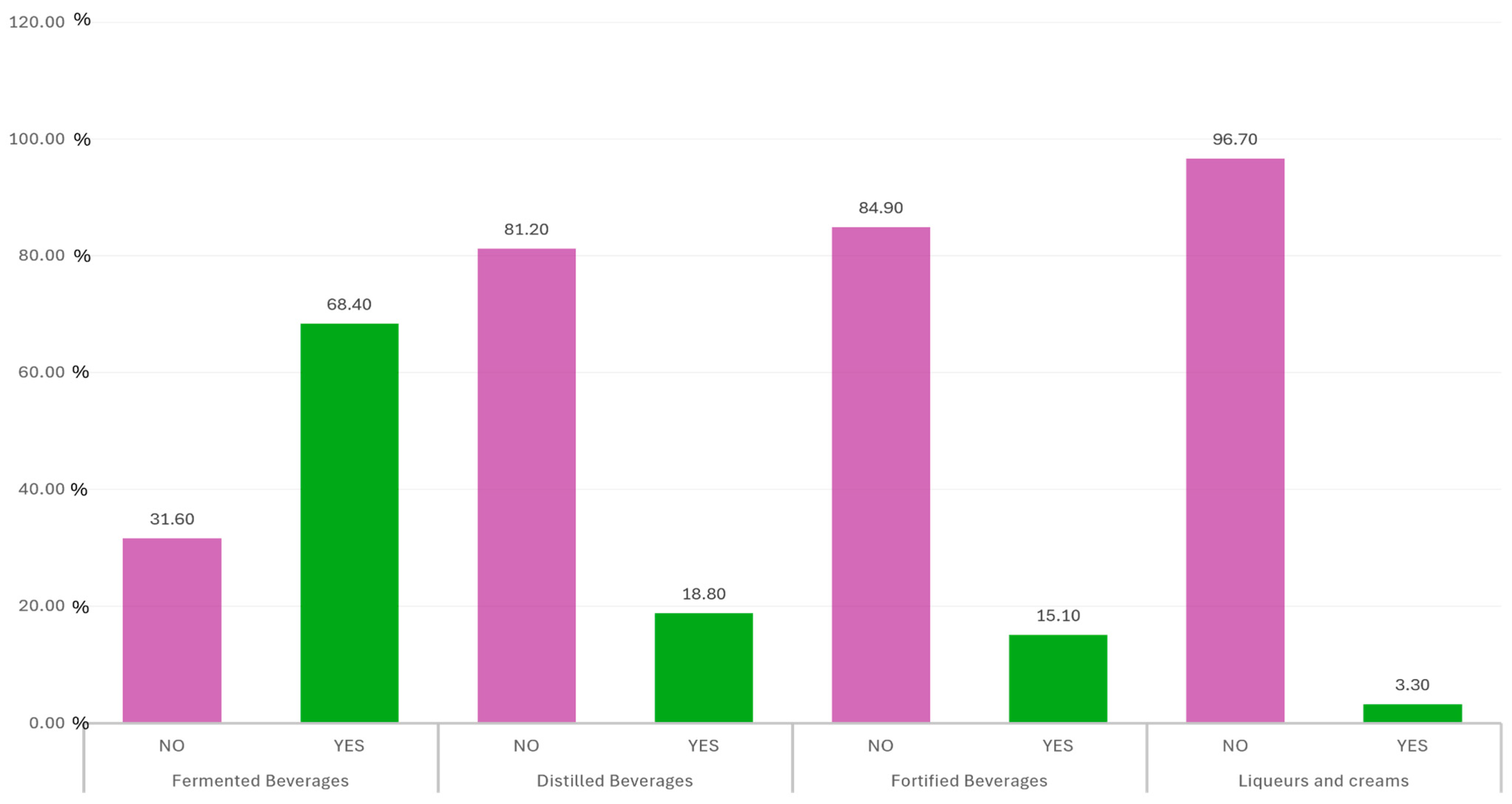
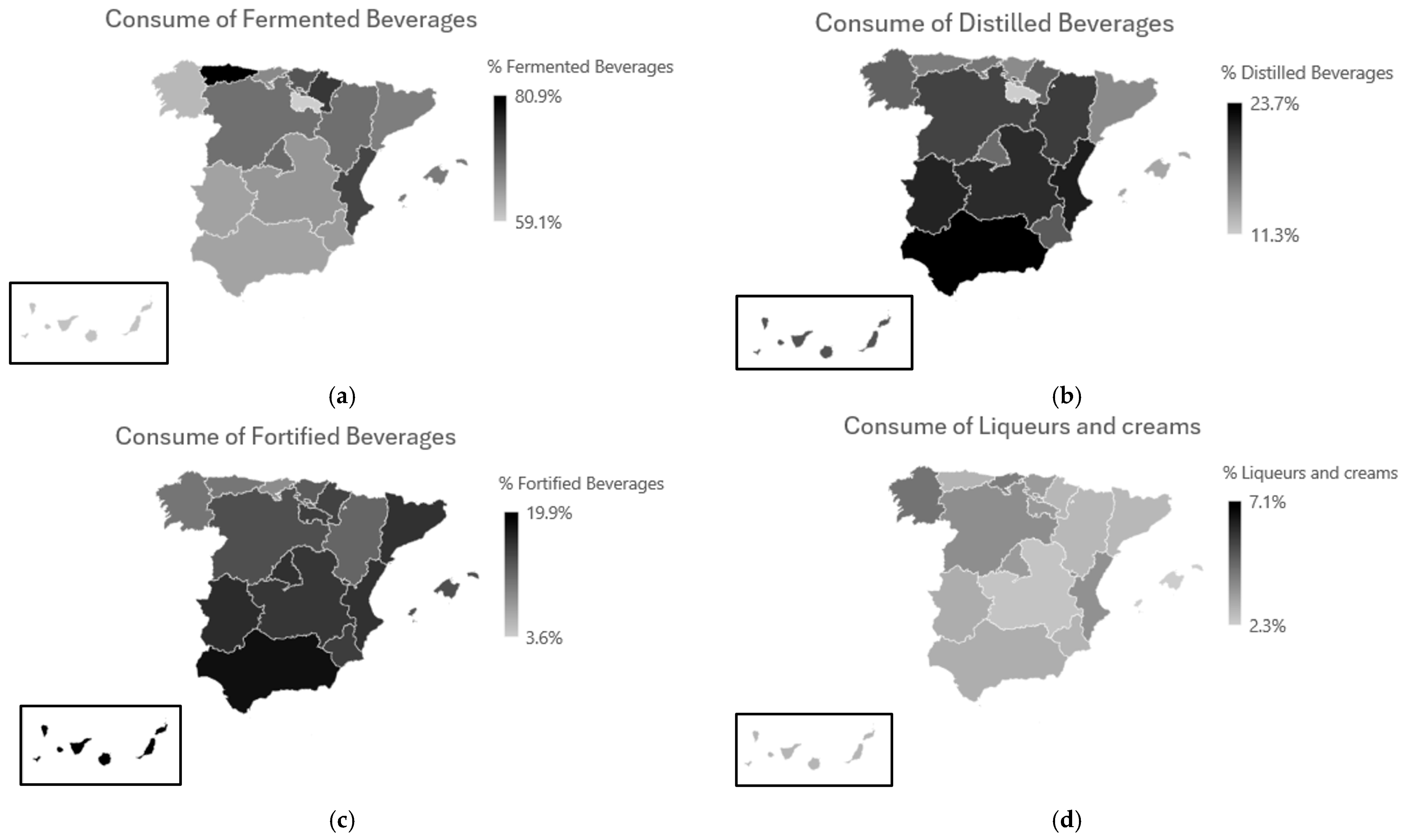
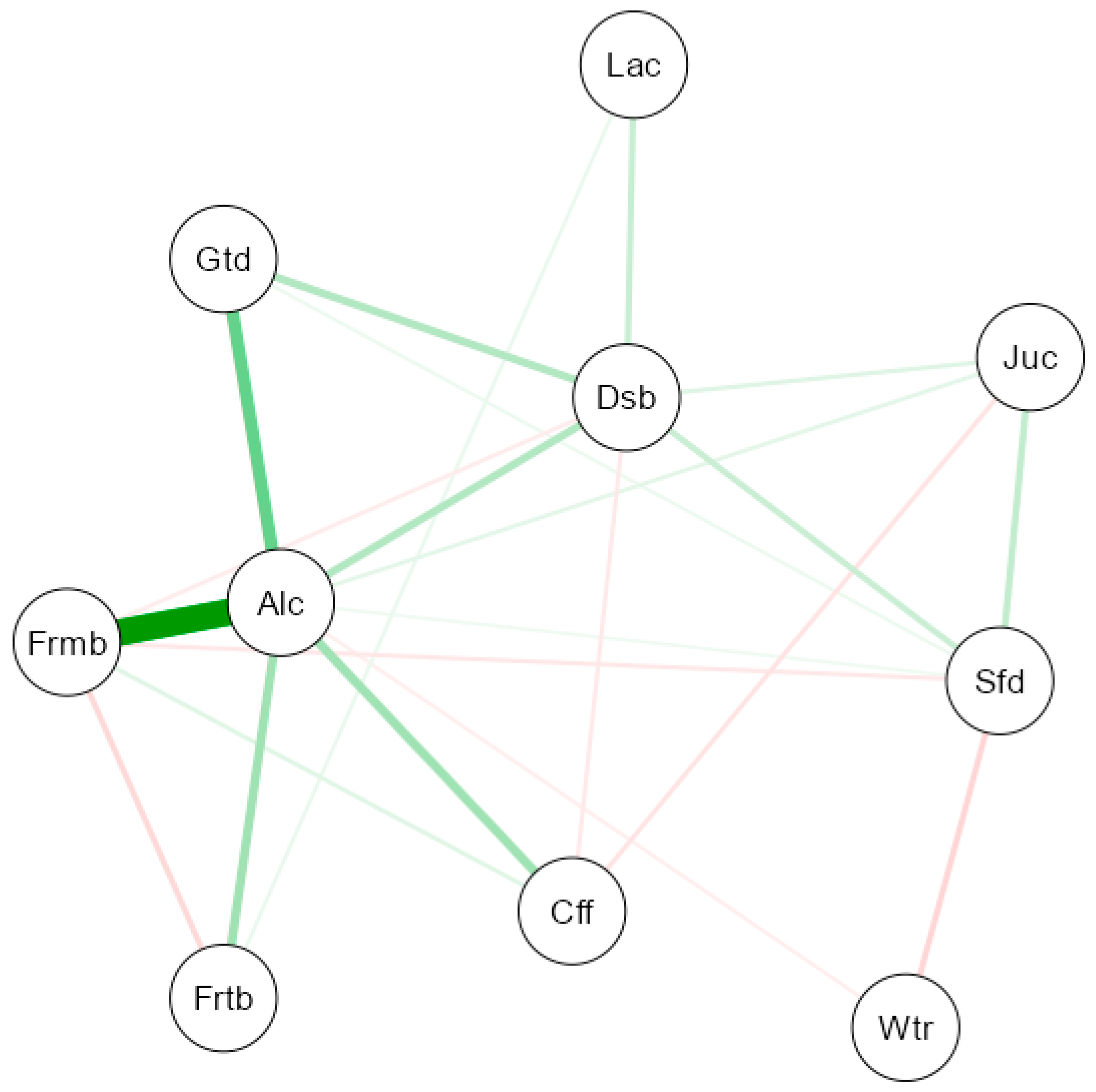
| Variable | Category | Score |
|---|---|---|
| Water | Never and very rarely (2 max. per month) and 1 glass/cup/week and ≥2 glasses/cups/week | 1 |
| 2 glasses/cups or less every day | 2 | |
| 3–5 glasses every day | 3 | |
| More than 5 glasses every day | 4 | |
| Sugary soft drinks, coffee, and energy drinks | Never and very rarely (2 glasses max. per month) | 4 |
| One glass per week and 2 or more glasses per week | 3 | |
| 2 glasses or less every day | 2 | |
| 3–5 glasses and ≥5 glasses every day | 1 | |
| Juice | Never and very rarely (2 glasses max. per month) | 1 |
| One glass per week and 2 or more glasses per week | 2 | |
| 2 glasses or less every day | 3 | |
| 3–5 glasses and ≥5 glasses every day | 4 | |
| Alcohol consumption | Never or once a month | 1 |
| 2–4 times a month | 2 | |
| 2–3 times a week | 3 | |
| 4–5 times a week or every day | 4 |
| Mean (SD) or N (%) | ||
|---|---|---|
| Sex | Male | 4251 (19.2%) |
| Female | 17,930 (80.8%) | |
| Age in years | Age total (years) | 34.9 (11.7) |
| Age male (years) | 36.5 (13.4) | |
| Age female (years) | 34.5 (11.2) | |
| Education level | Basic education | 7027 (31.7%) |
| Higher education | 15,154 (68.3%) | |
| Income level | Low | 9727 (43.9%) |
| Medium–high | 10,616 (47.9%) | |
| No answer | 1839 (8.3%) | |
| Municipality | <2000 | 1014 (4.6%) |
| 2000–10,000 | 3587 (16.2%) | |
| >10,000 | 17,580 (79.3%) | |
| Living arrangement | Living alone | 2202 (9.9%) |
| Not living alone | 19,979 (90.1%) | |
| Family life | Living with family | 16,732 (75.4%) |
| Living without family | 5449 (24.6%) | |
| Living area | North of Spain | 9602 (43.3%) |
| South of Spain | 12,579 (56.7%) | |
| Spanish communities | Andalusia | 2617 (11.8%) |
| Aragon | 652 (2.9%) | |
| Asturias | 661 (3.0%) | |
| Balearic Islands | 488 (2.2%) | |
| Basque Country | 925 (4.2%) | |
| Canary Islands | 637 (2.9%) | |
| Cantabria | 217 (1.0%) | |
| Castilla-La Mancha | 729 (3.3%) | |
| Castile and León | 1276 (5.8%) | |
| Cataluña | 3540 (16.0%) | |
| Ceuta and Melilla | 28 (0.1%) | |
| Community of Madrid | 3882 (17.5%) | |
| Extremadura | 395 (1.8%) | |
| Galicia | 1404 (6.3%) | |
| La Rioja | 115 (0.5%) | |
| Navarre | 324 (1.5%) | |
| Region of Murcia | 417(1.9%) | |
| Valencian Community | 3874 (17.5%) |
| All Sample | p-Value $ | Only Men (N = 4251) | p-Value $ | Only Women | p-Value $ | |||
|---|---|---|---|---|---|---|---|---|
| Male | Female | |||||||
| 1.97 (0.99) | 1.71 (0.83) | <0.001 | ||||||
| Young (18–30 years) | Adults (>30 years) | Young (N = 1835) | Adults (N = 2416) | Young (N = 7857) | Adults (N = 10,073) | |||
| 1.69 (0.78) | 1.80 (0.94) | <0.001 | 1.74 (0.81) | 2.13 (1.07) | <0.001 | 1.68 (0.77) | 1.72 (0.88) | 0.807 |
| Basic education | Higher education | Basic education (N = 1539) | Higher education (N = 2712) | Basic education (N = 5488) | Higher education (N = 12,442) | |||
| 1.66 (0.85) | 1.80 (0.88) | <0.001 | 1.83 (0.96) | 2.05 (0.99) | <0.001 | 1.61 (0.81) | 1.75 (0.84) | <0.001 |
| Low incomes | Medium–high incomes | Low incomes (N = 1646) | Medium–high incomes (N = 2305) | Low incomes (N = 8081) | Medium–high incomes (N = 8311) | |||
| 1.68 (0.84) | 1.84 (0.91) | <0.001 | 1.80 (0.93) | 2.11 (1.02) | <0.001 | 1.65 (0.81) | 1.77 (0.86) | <0.001 |
| Living with family | Living without family | Living with family (N = 3230) | Living without family (N = 1021) | Living with family (N = 13,502) | Living without family (N = 4428) | |||
| 1.83 (0.86) | 1.73 (0.87) | <0.001 | 1.98 (1.01) | 1.92 (0.91) | 0.304 | 1.67 (0.83) | 1.81 (0.85) | <0.001 |
| Living alone | Not living alone | Living alone (N = 459) | Not living alone (N = 3792) | Living alone (N = 1743) | Not living alone (N = 16,187) | |||
| 1.75 (0.87) | 1.85 (0.90) | <0.001 | 1.94 (0.97) | 1.97 (0.99) | 0.655 | 1.82 (0.87) | 1.69 (0.83) | <0.001 |
| Spanish Regions | Mean (SD) |
|---|---|
| Andalucía | 1.72 (0.86) |
| Aragón | 1.72 (0.87) |
| Cantabria | 1.67 (0.80) |
| Castilla y León | 1.75 (0.86) |
| Castilla-La Mancha | 1.65 (0.79) |
| Cataluña | 1.71 (0.86) |
| Ceuta y Melilla | 1.96 (1.04) |
| Navarra | 1.83 (0.86) |
| Comunidad Valenciana | 1.86 (0.94) |
| Comunidad de Madrid | 1.8 (0.88) |
| Extremadura | 1.67 (0.86) |
| Galicia | 1.62 (0.83) |
| Islas Baleares | 1.69 (0.85) |
| Canarias | 1.62 (0.74) |
| La Rioja | 1.71 (0.93) |
| País Vasco | 1.82 (0.87) |
| Asturias | 1.89 (0.86) |
| Región de Murcia | 1.65 (0.83) |
| Fermented Beverages N (%) | p-Value $ | Distilled Beverages N (%) | p-Value $ | ||||
| NO | YES | NO | YES | ||||
| Sex | Male | 1186 (27.9%) | 3065 (72.1%) | <0.001 | 3262 (76.7%) | 989 (23.3%) | <0.001 |
| Female | 5826 (32.5%) | 12,104 (67.5%) | 14,758 (82.3%) | 3172 (17.7%) | |||
| Age | Young (18–30 years) | 3254 (14.7%) | 6438 (29.0%) | <0.001 | 7323 (33.0%) | 2369 (10.7%) | <0.001 |
| Adults (>30 years) | 3758 (16.9%) | 8731 (39.4%) | 10,697 (48.2%) | 1792 (8.1%) | |||
| Education | Basic education | 2599 (37.0%) | 4428 (63.0%) | <0.001 | 5481 (78.0%) | 1546 (22.0%) | <0.001 |
| Higher education | 4413 (29.1%) | 10,741 (70.9%) | 12,539 (82.7%) | 2615 (17.3%) | |||
| Incomes | Low | 3337 (16.4%) | 6390 (31.4%) | <0.001 | 7948 (39.1%) | 1466 (7.2%) | 0.868 |
| Medium–high | 3064 (15.1%) | 7552 (37.1%) | 8684 (42.7%) | 1932 (9.5%) | |||
| Municipality | <2000 | 1304 (5.9%) | 2283 (10.3%) | <0.001 | 2903 (13.1%) | 684 (3.1%) | 0.647 |
| 2000–10,000 | 378 (1.7%) | 636 (2.9%) | 815 (16.8%) | 199 (0.9%) | |||
| >10,000 | 5330 (24.0%) | 12,250 (55.2%) | 14,302 (64.5%) | 3278 (14.8%) | |||
| Living arrangement | Living alone | 6423 (29.0%) | 13,556 (61.1%) | <0.001 | 16,232 (73.2%) | 3747 (16.9%) | 0.958 |
| Not living alone | 589 (2.7%) | 1613 (7.3%) | 1788 (8.1%) | 414 (1.9%) | |||
| Family life | Living with family | 1535 (6.9%) | 3914 (17.6%) | <0.001 | 4262 (19.2%) | 1187 (5.4%) | <0.001 |
| Living without family | 5477 (24.7%) | 11,255 (50.7%) | 13,758 (62.0%) | 2974 (13.4%) | |||
| Fortified Beverages N (%) | p-Value $ | Liqueurs and Creams N (%) | p-Value $ | ||||
| NO | YES | NO | YES | ||||
| Sex | Male | 3789 (89.1%) | 462 (10.9%) | <0.001 | 4101 (96.5%) | 150 (3.5%) | 0.316 |
| Female | 15,032 (83.8%) | 2898 (16.2%) | 17,352 (96.8%) | 578 (3.2%) | |||
| Age | Young (18–30 years) | 8352 (37.7%) | 1340 (6.0%) | <0.001 | 9362 (42.2%) | 330 (1.5%) | 0.366 |
| Adults (>30 years) | 10,469 (47.2%) | 2020 (9.1%) | 12,091 (54.5%) | 398 (1.8%) | |||
| Education | Basic education | 6006 (85.5%) | 1021 (14.5%) | 0.08 | 6756 (96.1%) | 271 (3.9%) | 0.001 |
| Higher education | 12,815 (84.6%) | 2339 (15.4%) | 14,697 (97.0%) | 457 (3.0%) | |||
| Incomes | Low | 8261 (40.6%) | 1466 (7.2%) | 0.601 | 9385 (46.1%) | 342 (1.7%) | 0.053 |
| Medium–high | 8988 (44.2%) | 1628 (8.0%) | 10,294 (50.6%) | 322 (1.6%) | |||
| Municipality | <2000 | 3037 (13.7%) | 550 (2.5%) | 0.179 | 3458 (15.6%) | 129 (0.6%) | 0.378 |
| 2000–10,000 | 881 (4.0%) | 133 (0.6%) | 977 (4.4%) | 37 (0.2%) | |||
| >10,000 | 14,903 (67.2%) | 2677 (12.1%) | 17,018 (76.7%) | 562 (2.5%) | |||
| Living arrangement | Living alone | 16,999 (76.6%) | 2980 (13.4%) | 0.004 | 19,310 (87.1%) | 669 (3.0%) | 0.094 |
| Not living alone | 1822 (8.2%) | 380 (1.7%) | 2143 (9.7%) | 59 (0.3%) | |||
| Family life | Living with family | 4575 (20.6%) | 874 (3.9%) | 0.035 | 5259 (23.7%) | 190 (0.9%) | 0.329 |
| Living without family | 14,246 (64.2%) | 2486 (11.2%) | 16,194 (73.0%) | 538 (2.4%) | |||
| Regions | Fermented Beverage | Distilled Beverage | Fortified Beverage | Liqueurs and Creams | ||||
|---|---|---|---|---|---|---|---|---|
| N | % | N | % | N | % | N | % | |
| Andalucía | 1666 | 63.66% | 621 | 23.73% | 476 | 18.19% | 79 | 3.02% |
| Aragón | 451 | 69.17% | 130 | 19.94% | 77 | 11.81% | 18 | 2.76% |
| Cantabria | 144 | 66.36% | 36 | 16.59% | 19 | 8.76% | 9 | 4.15% |
| Castilla y León | 881 | 69.04% | 249 | 19.51% | 172 | 13.48% | 48 | 3.76% |
| Castilla-La Mancha | 474 | 65.02% | 152 | 20.85% | 112 | 15.36% | 18 | 2.47% |
| Cataluña | 2394 | 67.63% | 545 | 15.40% | 557 | 15.73% | 98 | 2.77% |
| Ceuta y Melilla | 20 | 71.43% | 4 | 14.29% | 1 | 3.57% | 2 | 7.14% |
| Navarra | 242 | 74.69% | 58 | 17.90% | 47 | 14.51% | 9 | 2.78% |
| Comunidad Valenciana | 2840 | 73.31% | 838 | 21.63% | 612 | 15.80% | 143 | 3.69% |
| Comunidad de Madrid | 2701 | 69.58% | 671 | 17.28% | 615 | 15.84% | 134 | 3.45% |
| Extremadura | 252 | 63.80% | 84 | 21.27% | 64 | 16.20% | 12 | 3.04% |
| Galicia | 862 | 61.40% | 249 | 17.74% | 149 | 10.61% | 62 | 4.42% |
| Islas Baleares | 332 | 68.03% | 67 | 13.73% | 66 | 13.52% | 11 | 2.25% |
| Canarias | 384 | 60.28% | 119 | 18.68% | 127 | 19.94% | 18 | 2.83% |
| La Rioja | 68 | 59.13% | 13 | 11.30% | 17 | 14.78% | 4 | 3.48% |
| País Vasco | 664 | 71.78% | 142 | 15.35% | 117 | 12.65% | 32 | 3.46% |
| Asturias | 535 | 80.94% | 107 | 16.19% | 70 | 10.59% | 19 | 2.87% |
| Región de Murcia | 269 | 64.51% | 76 | 18.23% | 62 | 14.87% | 12 | 2.88% |
Disclaimer/Publisher’s Note: The statements, opinions and data contained in all publications are solely those of the individual author(s) and contributor(s) and not of MDPI and/or the editor(s). MDPI and/or the editor(s) disclaim responsibility for any injury to people or property resulting from any ideas, methods, instructions or products referred to in the content. |
© 2025 by the authors. Licensee MDPI, Basel, Switzerland. This article is an open access article distributed under the terms and conditions of the Creative Commons Attribution (CC BY) license (https://creativecommons.org/licenses/by/4.0/).
Share and Cite
Sandri, E.; Capoferri, M.; Luciani, G.; Piredda, M. Alcohol Consumption and Beverage Preferences in a Predominantly Female, Highly Educated Spanish Population: A Sociodemographic and Network Analysis. Foods 2025, 14, 1930. https://doi.org/10.3390/foods14111930
Sandri E, Capoferri M, Luciani G, Piredda M. Alcohol Consumption and Beverage Preferences in a Predominantly Female, Highly Educated Spanish Population: A Sociodemographic and Network Analysis. Foods. 2025; 14(11):1930. https://doi.org/10.3390/foods14111930
Chicago/Turabian StyleSandri, Elena, Michela Capoferri, Gaia Luciani, and Michela Piredda. 2025. "Alcohol Consumption and Beverage Preferences in a Predominantly Female, Highly Educated Spanish Population: A Sociodemographic and Network Analysis" Foods 14, no. 11: 1930. https://doi.org/10.3390/foods14111930
APA StyleSandri, E., Capoferri, M., Luciani, G., & Piredda, M. (2025). Alcohol Consumption and Beverage Preferences in a Predominantly Female, Highly Educated Spanish Population: A Sociodemographic and Network Analysis. Foods, 14(11), 1930. https://doi.org/10.3390/foods14111930







